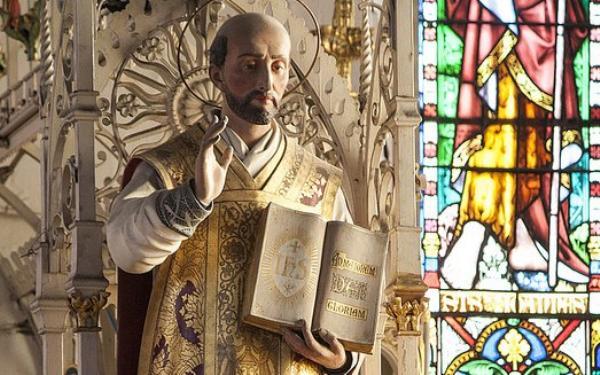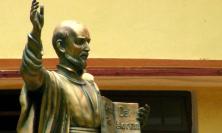In a homily for the Feast of St Ignatius Loyola on 31 July, Fr Michael Holman SJ described his visit to a chapel just outside Rome that Ignatius himself visited in 1537. As he prayed there, the founder of the Society of Jesus had an experience that informed his own mission; an experience which would, in turn, shape the identity of his companions and all those in Ignatian orders today.
![]() Listen to Fr Michael Holman’s homily for the Feast of St Ignatius.
Listen to Fr Michael Holman’s homily for the Feast of St Ignatius.
A few years ago, six or seven years ago to be more precise, I was fortunate to participate in a training programme in the Jesuit headquarters in Rome. We were sixteen on the course. The worldwide Society of Jesus which St Ignatius founded was well represented. There were men from North America and Europe; from Zambia and Malawi and Rwanda; from Goa, Madras, the Punjab and Calcutta; from Japan and even China.
To the surprise of many, this was my very first visit to Rome. So before, in between and after class – but, I can truthfully say, never missing a class – I set off to see some of the sights of the Eternal City
Our headquarters suits the would-be tourist down to the ground: it’s as close to the Vatican City as it is possible for anywhere outside the Vatican City to be. Turn left outside the front door, make your way along a cobbled street towards Bernini’s colonnade and in two minutes you are standing in St Peter’s Square.
As maybe you would expect from a training programme of this kind, there was no shortage of trips and tours organised to the many places in the city connected with the Society. We toured the Church of the Gesù and prayed at the tomb of Ignatius himself; we were guided around the rooms, in the Jesuit residence next door, where Ignatius had lived in the last years of his life as General of the Order; we visited the Roman College he had founded in 1550, or rather its successor the Gregorian University, where one morning we met the Jesuit faculty and were then entertained to lunch.
The visit which meant most to me took place later that same afternoon. We were asked if we would like to take a trip by train to a suburban town some twelve kilometres to the north-west of the centre of Rome. Most of us signed up to go.
Being men more accustomed to leading than to being led, there were the inevitable disputes. Was it better to walk to the station by this road or that? Having agreed the walking route, three promptly took the bus! Once on the train at the Stazione San Pietro there was another animated discussion: it was four stops, no it was six stops, no eight! After what seemed more like seven the train pulled in to our destination. We alighted and we were led, with great confidence, out one door of the station, across a car park to a bus stand where we all promptly did a U turn, went back into the station and out the door on the opposite side.
Five minutes and only one further mishap later we arrived and were standing inside our destination: a small chapel, measuring no more than six metres by six metres, dedicated to Our Lady, in the town of La Storta, by the side of the Via Cassia, a busy highway in the midst of the Friday afternoon rush hour. This is where we all wanted to be since it was here, long ago in 1537, that, in a sense, it all began.
Ignatius was travelling on foot from Vicenza to Rome with his first companion, Peter Faber, and with Diego Laynez, who more than twenty years later would succeed him as the second General of the Jesuits. It was here in this chapel that something happened to Ignatius, an experience that made a branding-iron impression upon him. If you want to know what it was that shaped and drove him and gave him and his first Jesuit companions their identity; if you want to know what still gives Jesuits and those others who follow the Ignatian way their identity today, then look to what happened in that chapel, one afternoon in the autumn of 1537. That’s why we wanted to be there, since it was there, in a real sense, that it all began.
When it came to describing the event himself, Ignatius used few words; his companion on that journey, Diego Laynez, gives a fuller report. Ignatius had for some time been praying earnestly for what it seemed mattered more than anything else. Ignatius was a man of big desires and when he sensed God wanted to give him something, he put his all and everything into obtaining it. Diego Laynez tells us that Ignatius was praying that he might be ‘placed with the Son’ and that he was determined to get all the help he could to obtain this grace: he was praying to Mary that she might intercede with Jesus to obtain from the Father this singular grace, to be ‘placed with the Son’.
Any journey was a pilgrimage for Ignatius. ‘Pilgrimage’ was a metaphor he also applied to his life which he understood as a journey with God and to God. So as they entered the village of La Storta and saw the shrine at the side of the road they called in to pray. As Ignatius prayed, it became clear to him that the Father had indeed ‘placed him with the Son’. Indeed, it was so clear to him that he had been ‘placed with the Son’ that, no matter what happened afterwards, he would never doubt that his prayer had been answered.
Facing us in that chapel that Friday afternoon was a mural of the scene as Diego Laynez had described it: Ignatius was being received by Jesus. This was not the Jesus of the nativity, not the Jesus of the hidden life, nor the Jesus of the Resurrection. Rather, Ignatius was there alongside Jesus who was carrying his cross.
This became, one might say, Ignatius’s core experience, one to which he constantly referred. The rest of his life lived it out; the decisions he took lived it out; the Society he founded was to live it out. When Ignatius died in 1556 and his Jesuit brothers looked through his notes about the many matters that he had dealt with as Jesuit General, they found again and again references to ‘when the Father was placing me with his Son’.
So when Ignatius and his first companions wondered what name their new religious congregation might take, it was clear that it had to take the name ‘the Company of Jesus’, since Jesus alone was their head. It was Jesus who had taken them all into his company, and that made them companions of him, companions of each other, friends in the Lord together, alongside Jesus, carrying his cross.
Their desire to live alongside Jesus, carrying his cross, set them free to make their specifically Jesuit contribution to the Church. It set them free to go where the need was greatest, to the frontiers, to those places where often no one else would go or could go, and when necessary to accept the suffering this involved. So Francis Xavier went to the furthest geographical frontiers of the Church, to India, to Japan, dying in sight of China; Peter Faber went to its internal frontiers, to Germany and to those frontiers where one interpretation of Christianity met another; and Ignatius himself went to arguably the toughest frontier of them all, to those places where the comfort of the past met the uncertainties of the future, as he accompanied and encouraged the Church in change.
And what was their motivation for it all? Not a policy programme, not a manifesto, but a relationship. Ignatius was a man in love. He had given his life for the Jesus who had given his life for him; that Jesus who made himself so affectively present that Ignatius, that hardened war veteran, could weep at the very thought of him. It wasn’t a matter of just doing his work; it had to be always more. Ignatius wanted to do that work as Jesus would have done it, with the mind of Jesus, with the heart of Jesus, always with the poor alongside Jesus, himself another Jesus. He wanted the name of Jesus to be deeply imprinted upon him. One day in 1544, holding the host at Mass, he found himself saying spontaneously that he would never abandon Jesus, not for all the world.
Such it was to be ‘placed with the Son’.
The chapel in which we stood that Friday afternoon was not the original chapel in which Ignatius had seen these things that mattered so clearly: that was long gone. This one had been built just thirty years before, replacing a shrine the US Air Force had unhelpfully blasted to bits as the Allies made their way towards Rome in 1944.
Writing to the Society of Jesus as we made preparations seven years ago to celebrate the Jubilees of Ignatius and his first companions, Fr General Kolvenbach, then our superior general, asked us to remember that Ignatius, Francis Xavier and Peter Faber are not history lessons, but men whose spirit is to be lived today.
It was Fr Pedro Arrupe, the superior general of the Society in the fifteen years following the Second Vatican Council, who had been responsible for the rebuilding of the Chapel at La Storta. I have only the dimmest personal memories of this remarkable man who bore an uncanny resemblance to Ignatius himself. But his memory was alive for us that afternoon in La Storta, for in so many ways he is the one who tells us what it means to live the spirit of Ignatius and the first companions; tell us what it means to be ‘placed with the Son’ today. And that ‘us’ includes Pope Francis whose affection for Fr Arrupe is clear and who prayed at his tomb in the Gesù Church this morning.
Many of us have heard before, but it’s worth hearing again, how Fr Arrupe was famously asked in an interview a question that took him by surprise since the interview was about other topics entirely. ‘Fr Arrupe, what does Jesus Christ mean for you?’ ‘For me,’ Arrupe replied, ‘Jesus Christ is everything. For me, Jesus Christ is everything….Take Jesus from my life and everything would collapse – like a human body from which someone had taken the heart, the bones, the head. For me, Jesus Christ is everything.’
To be a follower of Ignatius in today’s Church, as Pope Francis shows, is to be one for whom Jesus Christ is everything, one who desires nothing more than that Jesus be everything for every other man and woman today and who dares to say so. A follower of Ignatius is one who makes his or her faith in Jesus known by living the Gospel of Jesus as Jesus lived it, with the whole of life, and who makes it credible by living with the poor, for the poor, amongst the poor, following Christ poor. A follower of Ignatius is one who has encountered Christ and helps others meet him too; one who can bring Christ to the toughest issues of our time; one who can travel with people who struggle with those issues, knowing that he or she often struggles with them as well – creatively, one hopes, but faithfully and truthfully too.
As this evening we all gather to give thanks to God for the gift of Ignatius to the Church, please pray for all who follow the way of Ignatius, for us Jesuits, and above all for our brother Pope Francis, that the spirit of Ignatius might be alive in us. Please pray that we might want nothing more than to be placed with the Son carrying his cross and so truly be companions of Jesus in our service of the Church and of all God’s good people today.
Michael Holman SJ is Principal of Heythrop College, University of London.
This is the text of a homily delivered at the Church of the Immaculate Conception, Farm St, Central London on Wednesday 31 July 2013, the Feast of St Ignatius.
![]() Listen to Fr Michael Holman’s homily for the Feast of St Ignatius:
Listen to Fr Michael Holman’s homily for the Feast of St Ignatius:






